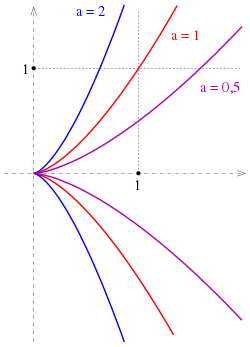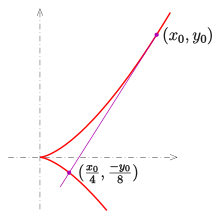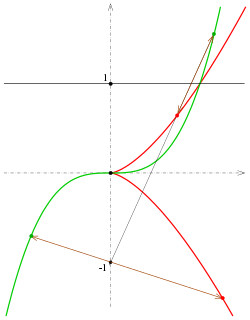Semicubical parabola
In mathematics, a cuspidal cubic or semicubical parabola is an algebraic plane curve defined by an equation of the form
- (A)

Solving for leads to the explicit form
- (E1)
which is the cause for the term semicubical parabola.
(A parabola in the common sense can be described by an equation .)
Solving (A) for yields the second explicit form
- (E2)
Equation (A) shows, that
- (P)
is a parametric representation of the curve. [1]
The arc length of the curve was calculated by the English mathematician William Neile and published in 1657 (see section History). [2].
Properties of semicubical parabolas
Similarity
- Any semicubical parabola is similar to the semicubical unit parabola .
Proof: The similarity (uniform scaling) maps the semicubical parabola onto the curve with .
Singularity
- The parametric representation is regular except at point . At point the curve has a singularity (cusp).
The proof follows from the tangent vector . Only for this vector has zero length.

Tangents
Differentiating the semicubical unit parabola one gets at point of the upper branch the equation of the tangent:
This tangent intersects the lower branch at exactly one further point with coordinates [3]
(Proving this statement one should use the fact, that the tangent meets the curve at twice.)
Arclength
Determining the arclength of a curve one has to solve the integral . For the semicubical parabola one gets
(The integral can be solved by the substitution .)
Example: For (semicubical unit parabola) and , which means the length of the arc between the origin and point , one gets the arc length
Evolute of the unit parabola
- The evolute of the parabola is a semicubical parabola shifted by 1/2 along the x-axis:
Polar coordinates
In order to get the representation of the semicubical parabola in polar coordinates, one determines the intersection point of the line with the curve. For there is one point different from the origin: . This point has distance from the origin. With and ( see List of identities) one gets [4]

Relation between a semicubical parabola and a cubic function
Mapping the semicubical parabola by the projective map (involutoric perspectivity with axis and center ) yields , hence the cubic function . The cusp (origin) of the semicubical parabola is exchanged with the point at infinity of the y-axis.
This property can be derived, too, if one represents the semicubical parabola by homogeneous coordinates: In equation (A) the replacement (the line at infinity has equation .) and the multiplication by is performed. One gets the equation of the curve
- in homogeneous coordinates:
Choosing line as line at infinity and introducing yields the (affine) curve
Isochrone curve
An additional defining property of the semicubical parabola is that it is an isochrone curve, meaning that a particle following its path while being pulled down by gravity travels equal vertical intervals in equal time periods. In this way it is related to the tautochrone curve, for which particles at different starting points always take equal time to reach the bottom, and the brachistochrone curve, the curve that minimizes the time it takes for a falling particle to travel from its start to its end.
History
The semicubical parabola was discovered in 1657 by William Neile who computed its arc length. Although the lengths of some other non-algebraic curves including the logarithmic spiral and cycloid had already been computed (that is, those curves had been rectified), the semicubical parabola was the first algebraic curve (excluding the line and circle) to be rectified.[1]
References
- Pickover, Clifford A. (2009), "The Length of Neile's Semicubical Parabola", The Math Book: From Pythagoras to the 57th Dimension, 250 Milestones in the History of Mathematics, Sterling Publishing Company, Inc., p. 148, ISBN 9781402757969.
- August Pein: Die semicubische oder Neil'sche Parabel, ihre Sekanten und Tangenten ,p.2
- August Pein: Die semicubische oder Neil'sche Parabel, ihre Sekanten und Tangenten ,p.26
- August Pein: Die semicubische oder Neil'sche Parabel, ihre Sekanten und Tangenten ,p. 10
- August Pein: Die semicubische oder Neil'sche Parabel, ihre Sekanten und Tangenten , 1875, Dissertation
- Clifford A. Pickover: The Length of Neile's Semicubical Parabola